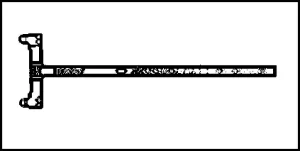- Best Archery Accessories 2024 - March 19, 2022
- Bow string:Why does it keep hitting my arm? - February 2, 2022
- Bow square: A how to guide - February 2, 2022
In every archer’s arsenal, you need a bow square. It is also known as the T-square for those of you who do not know it as the bows square. You use it as a measuring device and clips to the bow string. You will find measurement lines on both sides running horizontally and vertically.
In contrast, others look like a long ruler that is flat or rounded. If you are a compound bow archer, you may prefer using the round square, and Recurve archers choose the flat option. So what do you use the bow square for?
1. Set the Nocking Point On Bow String
If you are a Recurve bow user, you will use the T-square in different ways. You can use it to set the nocking points on the bow by clamping the device to the string. You put the ruler on the arrow rest or the shelf referred to as the perpendicular ruler sitting against the bowstring.
Values let you know where the zero “dead centers” are located with lines measured in 16-inches above/below the zero. If you shoot Formula or ILF Recurve bows, you will also use the T-square to help check the tiller measurements for the limbs from top to bottom.
You take the tiller measurement from the limb’s belly above or below the riser–depending on if you measure the base or top stem to string using a level plane.

2. Measuring the Tiller of the Bow Top Limb
In archery, the tiller measurement can affect how the bow sits in hand. If it is not correct to your preference or shooting style, it may lean forward/backward. Furthermore, the tiller makes sure that both limbs work together.
As an archer, you may want the measurement the same between the limbs and string, and others prefer the one to be longer than the other. You make a tiller adjustment by turning the limb bolts in/out. However, the most frequent use for the T-square as a Recurve archer is to measure the brace height, which is the distance from the deepest part of the grip and bowstring.
If you want to shoot consistently, the distance needs to be the same and requires changing every day.
3. Measure Brace Height
Every time you change your bowstring, you need to measure the brace height. The same applies if you should repeatedly or periodically. When measuring and it is longer than average, you need to unstring your bow and make a couple of twists out of the string. If below average, you need to add some twists to the string.
Setting up the Nocking Point on Compound Bows
Compound bow archers will use the bow square with the initial setup to help position the nocking position. You may prefer using a rounded square as it has a long cylindrical ruler that imitates the arrow shaft. The shaft will sit on the arrow rest while you clip the other end to the string.
You will notice lines vertically indicating where the nocking position is with D-loop material and placed in such a way to surround the arrow. When it comes to setting the nocking spine, compound archers like to nock the arrow a bit above the dead center, and a bow square makes it easier to achieve this. Hopefully you found this archerybeginnersguide article helpful.
